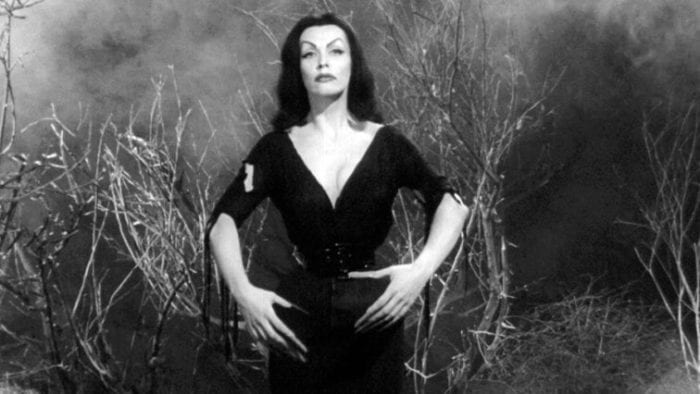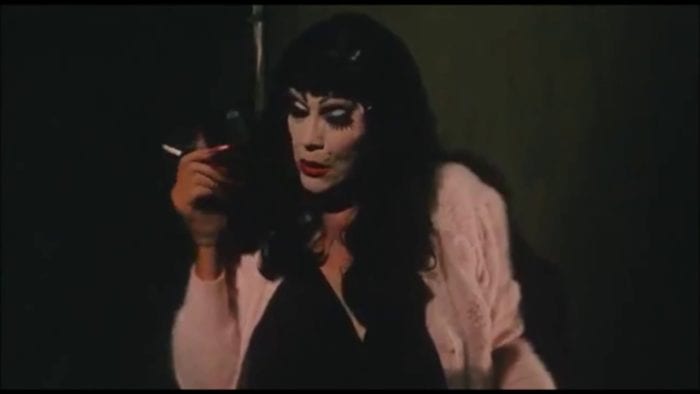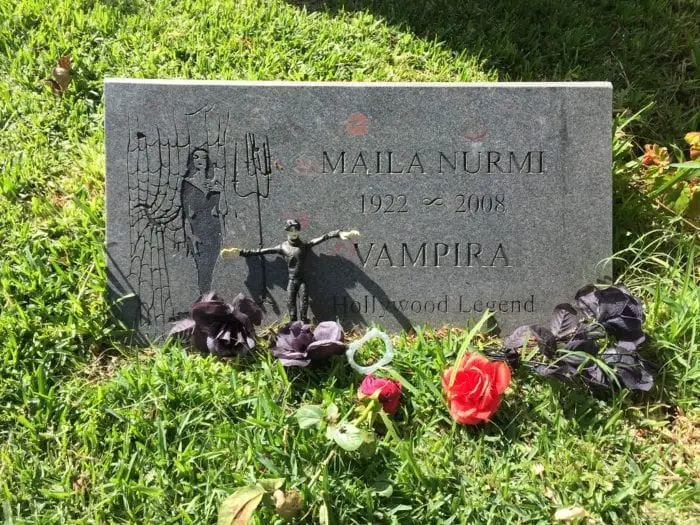The year is 1954. Lucille Ball is the undisputed queen of the new medium of television. If you could go back to that era and tune into KABC TV at 11 PM, you would be in for something different. A woman with an exaggerated hourglass silhouette glides down a smoky corridor to eery music. She steps into the light which reveals straight black hair, extremely arched dark brows, long, pointed fingernails, and a skin-tight black dress with a neckline that plunges to dangerous depths. She lets out a piercing scream, then gives a satisfied grin and says “Screaming relaxes me so.” The Vampira Show was an instant hit for its host, Maila Nurmi. Her character would remind you of Morticia Addams. The Addams Family wasn’t a TV show yet, but their macabre matriarch, Morticia, did have a lot to do with Vampira’s creation. Created by Charles Addams, The Addams Family was a series of single-panel cartoons featured in The New Yorker. At the time, none of Addams’s characters had names.
Nurmi was invited to a costume party in Los Angeles. She was determined to get noticed and put together a vampire costume inspired by Addams’s female character. A 2008 Los Angeles Times article quotes Nurmi as saying, “I bound my bosoms so that I was flat-chested, and I got a wig and painted my body a kind of a mauve white pancake with a little lavender powder so that I looked as though I’d been entombed.” Nurmi won first prize and did get noticed—by KABC Program Director Hunt Stromberg. Television was still in its infancy, and most Hollywood films weren’t released to show on TV yet. Stromberg had access to low-budget, independent horror movies and was looking for an interesting way to present them. He kept thinking of the woman in the vampire costume. He asked around to find out who she was. Designer Rudy Gernreuch recognized her as the “first woman in Southern California to wear backless shoes,” and gave Stromberg her name—Maila Nurmi. [1]
She was born Maila Elizabeth Niemi on December 11, 1922, in Gloucester, Massachusetts. Her father, Onni Niemi (formerly Syrjäniemi), was a Finnish immigrant, and her mother, Sophia Peterson, was an American of Finnish descent. The family eventually settled in Astoria, Oregon. After Nurmi graduated from Astoria High School in 1940, she moved to Los Angeles and New York to pursue acting and modeling. She modeled for some pin-up artists and photographers. In 1944, she was reportedly fired by Hollywood icon Mae West from West’s Broadway show Catherine Was Great. Nurmi was working as an extra in the show, but West felt Nurmi upstaged her. Her Broadway credits include a horror-themed midnight show, Spook Scandals, which included Nurmi lying in a coffin and lurking around in a cemetery. She also worked as a showgirl and as a chorus line dancer alongside burlesque dancer Lili St. Cyr. During the 1950s, she posed for pin-up photos for magazines such as Famous Models, Gala, and Glamorous Models. She also worked as a hat-check girl in a cloakroom on Hollywood’s Sunset Strip.
Stromberg didn’t want to step on Charles Addams’s toes. When he contacted Nurmi, he asked her if she could put a different spin on the character she dressed as for the party. Nurmi looked to comics, silent films, and Disney for inspiration: The Dragon Lady from a comic strip, Terry and The Pirates, silent film actress Theda Bara, aka The Vamp, and the evil queen from Snow White and the Seven Dwarves. She also took inspiration from Bizarre, a magazine that featured bondage-inspired images of “cruel and corseted women.” Nurmi decided to add sex to death. [2]
She said in an interview on The Haunted World of Edward D. Wood, Jr. that she thought that they made a good combination. She made her long, pointed nails herself from melted-down plastic food containers, fit them to her fingers, and fastened them with airplane model glue. She whittled her waist down to a freakishly small 17 inches with more than just a corset. Nurmi rubbed a mixture of papaya powder (used in meat tenderizer) and cold cream on her middle which she then bound with a rubber inner tube. “My waist just melted,” Nurmi said. “It was digesting my flesh.” [3]
Nurmi’s Vampira was a fusion of sensuality and macabre sensibility that had never been presented to the public before. She turned the blonde, rosy voluptuousness of the cheesecake pin-up upside down with jet black hair and a figure both gaunt and pale with the exaggerated curves of an hourglass figure. Her glamour was an eccentric exaggeration of the current fashionable ideal with a touch of kink. She was a macabre Mae West, who took bubble baths in boiling cauldrons, cracked jokes about electric chairs, and drank vampire cocktails (made from formaldehyde, vulture blood, and garnished with a glass eye).
TV audiences loved it, and Nurmi’s Vampira became popular. The Vampira Show debuted in March 1954, and by June, Life and Newsweek magazines featured articles about the self-styled glamour ghoul. Perhaps Mae West forgot about crossing paths with Nurmi on Broadway. West reportedly enjoyed The Vampira Show so much that she would send Nurmi Swedish meatballs to the studio after the show. [4] The Los Angeles Times quotes Nurmi speaking of Vampira’s popularity:
The times […] were so conservative and so constrained. There was so much repression, and people needed to identify with something explosive, something outlandish and truthful.

Nurmi would often go out in public in as Vampira, complete with a black parasol. She could be seen everywhere in LA from exclusive restaurants to jazz clubs. Nurmi’s main haunt was Googies coffee shop, which is where she first met actor James Dean, with whom she became friends. At the time, Dean was not yet famous but had been in a few films. Nurmi was at Googies with some friends and saw Dean through the window. She told her companions that she just had to meet him, and one of them introduced her.
It turns out that while Nurmi was playing a character with a very macabre sense of humor, Dean did have a macabre sensibility. Nurmi recalled the first time she was with Dean at his apartment. He talked about a play that he wanted to produce about a boy with an overbearing mother who hangs himself. She noticed a noose hanging from his ceiling and asked him why he was so preoccupied with hanging. He said that that was how he was going to die—with a broken neck. Dean also made recordings where he rambled on about what it would be like to be in a casket in a dark grave. In high school, he dressed up like Boris Karloff’s Frankenstein monster for a comedy revue called Goon with the Wind and recalled feeling powerful in the monster makeup.
Nurmi recalled that she would meet him at midnight while still wearing her Vampira costume without the wig, with another male friend driving. She said that they never talked about horror or Vampira. Dean appeared on Nurmi’s show once—with his back to the camera. She was performing a skit as Vampira as a librarian about to discipline someone by cracking their knuckles with a ruler. Dean happened to be on set, but no one recognized him. Someone asked him if he could be in the scene. He stood with his back to the camera as Nurmi cracked his knuckles.
At the beginning of her relationship with Dean, Nurmi was the celebrity. As Dean became popular, rumors circulated that he and Nurmi were dating. Dean responded by saying, “I don’t date cartoons.” He added that Vampira was “a subject about which I wanted to learn.” Nurmi was angry and hurt but always said that their relationship was platonic. She was married at the time to TV and film writer Dean Riesner.
Dean’s star would rise, but unfortunately, Nurmi’s would fade. Nurmi said that her show was canceled because she wouldn’t relinquish all rights to the Vampira character. The Vampira Show was canceled in November 1954 after eight months on the air. Nurmi decided to move back to New York and go back to Broadway. In June of 1955, Nurmi survived a violent attack. She answered the door to a man, later identified as Ellis Barber, aka The Vamp, who forced his way into her apartment. He assaulted Nurmi for two hours. She tried to escape, but Barber managed to catch and bring her back to her apartment, where he told her she would be dead by dawn. She eventually escaped. A man in a nearby store found her, covered in bruises, scratches, and wearing only a pair of torn slacks. He called the police, Barber came back and was arrested. Nurmi moved back to California.
Liberace asked her to perform in a show with him in Las Vegas, and she also did some pin-up modeling as Vampira. Nurmi sent James Dean a photo of herself sitting near an open grave. She wrote, “Having a wonderful time—wish you were here.” Someone saw the photo, took it as a threat, and got rid of it before Dean saw it. When Dean found out, he called Nurmi who explained that it was just a joke. On September 30, 1955, Dean died in a car accident—his neck was broken. The tabloids published stories about Nurmi’s connection to Dean. The articles referred to Nurmi as Dean’s “Black Madonna,” and suggested that Nurmi put a hex on Dean and caused his death. In a 1975 interview, Nurmi recalled that “I couldn’t attract anyone who wanted to live. Necrophiliacs would send me erotic poems, leave decapitated animals on the front porch.” [5]
After Vampira, other eccentric horror movie hosts began showing up on TV. Nurmi appeared in character as Vampira in Ed Wood‘s 1959 cult classic Plan 9 From Outer Space. Nurmi met Wood at a party during the height of her popularity. At the time she met Wood, Nurmi was far from impressed by him. When he approached her in 1956, her career was in a severe decline. Her situation was so bad that she accepted Wood’s offer of $200 to appear in the film. The LA Times records her speaking to her financial hardship during that time: “I was scraping by on $13 a week. I thought, ‘Well, here I go. I’m going to commit professional suicide right now.'” Besides Plan 9, not much footage is left of her as Vampira except some brief scenes available on YouTube.

After Plan 9, Nurmi found herself having to expand her horizons beyond show biz. She said the following in a 1962 LA Times interview: “I’m a lady linoleum-layer. And if things are slow in linoleum, I can also do carpentry, make drapes or refinish furniture.” She told Entertainment Weekly in 1994 that she cleaned celebrity homes for $0.99 an hour. Nurmi opened an antique shop, Vampira’s Attic, but still found herself in a financial cul-de-sac.
Two punk bands wrote songs that pay tribute to Vampira: The Damned’s “Plan 9, Channel 7” (1979) and The Misfits’ “Vampira” (1982). In 1987, she recorded two songs, “I am Damned” and “Genocide Utopia” with the band Satan’s Cheerleaders. In 1989, Nurmi unsuccessfully tried to sue Cassandra Peterson, aka Elvira, alleging that Elvira was a blatant knock-off of Vampira. The Times of NorthWest Indiana quotes her as saying, “There is no Elvira. There’s only a pirated Vampira. Cassandra Peterson slavishly copied my product and made a fortune. America has been duped.”
Nurmi lost the case. Peterson’s response was that Nurmi’s allegations were “ridiculous.” When trying to name Peterson’s character, a bunch of names were thrown up into a hat. The name Vampira was drawn. Peterson tried to register the name and found out that it was already registered to Nurmi. Peterson contacted Nurmi who was willing to allow Peterson to use the name for a large sum of money that no one was willing to pay. As for Elvira’s creation, Nurmi has never been mentioned. Peterson has said to Huff Post that Elvira was a collaborative effort between her and an artist friend Robert Redding. Peterson’s Elvira look was drawn from a combination of Kabuki theater and 1960s girl groups, with a bit of 1980s metal thrown in.
Over the years, Vampira’s image has appeared in various forms. Her influence on pop culture has been seen and heard since 1954. During the 1960s, Charles Addams’s creation made it to the small screen. The audience who once loved Vampira was introduced to Morticia Addams, who inspired Nurmi’s creation. Nurmi’s Vampira went on to inspire numerous artists and entertainers from punk bands to drag queens. Her image goes beyond figurines and Halloween and even graces guitar cases and skateboards. Vampira’s image also graced the big screen with Lisa Marie’s performance as Nurmi in Tim Burton’s film Ed Wood (1994).

Nurmi was proud of her creation and made paintings of her alter ego, which she sold online later on in life. In the 2008 LA Times article which was published within a week of her death, she was quoted as saying, “I don’t have any babies or any social history that’s remarkable, so I’m leaving something behind, you know, when the time comes to say goodbye, I’m leaving something.” Maila Nurmi passed away of natural causes on January 10, 2008, at the age of 85 and at her home in Hollywood. She was buried in Hollywood Forever Cemetery.
Work Cited
[1] Skal, David J., The Monster Show: A Cultural History of Horror (New York: Faber and Faber, 1993), p. 240
[2] Skal, p. 240
[3] Skal, p.241
[4] Skal, p. 242
[5] Skal, p. 246



